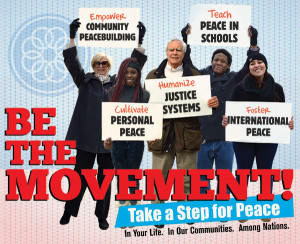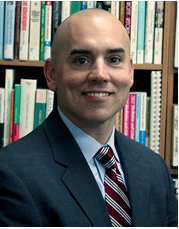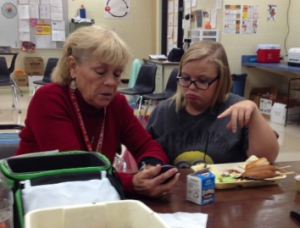News & Announcements
- Details
- Written by Joshua Wachtel
Students and teachers from Maine schools that are implementing the SaferSanerSchools Whole-School Change program as part of a 5-year RAND study speak about the positive impact in the classroom of circles and other informal restorative practices. These practices give everyone a chance to be heard.
- Details
- Written by Joshua Wachtel
 The borderlands of Pakistan and Afghanistan are a dangerous and violent place. But it is here that a student of restorative justice, Ali Gohar, founder of Just Peace Initiatives, based in Peshawar, Pakistan, has worked to reinvigorate and reinvent traditional conflict resolution practices.
The borderlands of Pakistan and Afghanistan are a dangerous and violent place. But it is here that a student of restorative justice, Ali Gohar, founder of Just Peace Initiatives, based in Peshawar, Pakistan, has worked to reinvigorate and reinvent traditional conflict resolution practices.
In this tribal region, inhabited largely by ethnic Pukhtoon, wrongdoing can spiral into cycles of vengeance. Family feuds can last for generations. For instance, nearly 60 years after the event, a man avenged his father’s murder by in turn killing the original murderer’s grandson. Revenge killings continued back and forth between the two families until a total of a dozen people were dead. Without the intervention of the jirga – a tribal council “organized by wise, respectable, greybeard elders whose decision is unanimous, acceptable to all community members” (Gohar, n.d.) – the cycle of violence would have continued. The jirga sent representatives to each family and convinced them to end the feud “for the sake of God” with no blood money exchanging hands (Lofton, 2015).
- Details
- Written by Joshua Wachtel
During the IIRP Europe 2015 Conference in Budapest, Hungary, Romanian social worker Izabella Kasza discussed her work with a displaced Roma population in the city of Cluj. The group of 300 families lives and works in poor conditions near the city's landfill.
- Details
- Written by Joshua Wachtel
 As the restorative practices social movement gathers steam in schools, justice, communities and beyond, practitioners, academics and advocates are looking for new ways to connect and work together to common purpose.
As the restorative practices social movement gathers steam in schools, justice, communities and beyond, practitioners, academics and advocates are looking for new ways to connect and work together to common purpose.
The Peace Alliance, a national grassroots advocacy group based in Washington, D.C., that promotes practical methods for reducing violence, transforming conflict and enhancing cooperation, sees as one of its functions to facilitate these cross connections.
- Details
- Written by Joshua Wachtel
Justice
The New York Times quotes Dr. Keith Jensen, co-author of a study showing young children have a sense of justice: "[G]iven a choice [toddlers] would rather restore things to help the victim than punish the perpetrator."
Law Street examines "How Can Restorative Justice Change the Criminal System?" illustrated with a number of embedded videos.
Restorative justice pioneer Howard Zehr was “roasted” during a celebration of the anniversary edition of his groundbreaking book, “Changing Lenses.”
- Details
- Written by Laura Mirsky
 The first IIRP Europe Conference brought 160 people from 23 countries to Budapest, Hungary, on June 10-12, 2015. For three intense days, participants shared stories, practices and research on restorative practices in criminal justice, education, social services, the workplace, faith communities and other settings. They heard how restorative practices are overcoming centuries of distrust between the Roma people and others in Romania, reintegrating prison inmates back into society in Hungary and helping heal victims of sexual abuse in Ireland. In circle discussions, they brainstormed how restorative practices can improve civil society all over the world. Everyone left the conference inspired to take what they learned back home.
The first IIRP Europe Conference brought 160 people from 23 countries to Budapest, Hungary, on June 10-12, 2015. For three intense days, participants shared stories, practices and research on restorative practices in criminal justice, education, social services, the workplace, faith communities and other settings. They heard how restorative practices are overcoming centuries of distrust between the Roma people and others in Romania, reintegrating prison inmates back into society in Hungary and helping heal victims of sexual abuse in Ireland. In circle discussions, they brainstormed how restorative practices can improve civil society all over the world. Everyone left the conference inspired to take what they learned back home.
Each day began with plenary presentations, attended by all the participants, followed by a large selection of “breakout” sessions.
- Details
- Written by Joshua Wachtel
Schools
Across the U.S., schools are Minding the Discipline Gap in Education between white and minority students by turning to restorative practices:
- The Oakland, CA, school board unanimously votes to end suspensions for willful defiance and funds restorative justice.
- Education activists in Charlotte-Mecklenburg, NC, want schools to adopt restorative justice as an alternative to suspension. (See also O.N.E. Charlotte pushes for restorative justice in CMS.)
- Denver, CO, Public Schools increase their investment in restorative practices, reducing their suspensions since 2005 from 16,000 to 6,300 and expulsions from over 250 to 67.
- John Marshall Law School has been awarded a grant to expand anti-violence restorative justice work in a Chicago Public School.
- Eighteen Loudoun, VA, high, middle & elementary schools adopt restorative practices and decrease suspensions in incidents of fighting, bullying, harassment and disrespect.
- Details
- Written by Joshua Wachtel
When civil unrest erupted in Baltimore, MD, during the last week of April 2015, schools that had been implementing restorative practices all year employed talking circles to help students feel safe, heard and restored. Unlike their counterparts in many other schools in the city, these schools felt prepared to respond in a way that strengthened their school communities.

“It was a tense few days,” says Corey Basmajian, principal of Windsor Hills Elementary/Middle School, in West Baltimore, referring to the feeling not only in his school but throughout Baltimore.
In West Baltimore, protests had begun April 18 over the police’s treatment of Freddie Gray, who would die on April 19 of spinal injuries sustained during an arrest April 12. By Friday April 25, some of the protests had turned violent. The unrest peaked the night of Monday April 27, after Gray’s funeral. Baltimore City Schools responded by closing on Tuesday April 28. But when students returned to classes on Wednesday, everyone was anxious about how they would act in light of all the unrest taking place in the city.
- Details
- Written by John Bailie
 "We're excited to bring together some of the country's most important leaders in school climate reform, to collaborate at the IIRP's first Presidential Symposium." - John Bailie, Ph.D., IIRP president
"We're excited to bring together some of the country's most important leaders in school climate reform, to collaborate at the IIRP's first Presidential Symposium." - John Bailie, Ph.D., IIRP president
The International Institute for Restorative Practices (IIRP) presents a Symposium, Integrating School Climate Reform Efforts: Join the Conversation with National Leaders, July 20 – 21, 2015, at its campus in Bethlehem, PA.
Dr. John Bailie, IIRP president, will be facilitating the Symposium. He is excited about its possible outcomes and potential for impact and shares his thoughts about it.
- Details
- Written by Joshua Wachtel
 Student Odessa Reid helps Grandma – Suzanne Ham, CLC's 'foster grandparent' – learn to program her new phone over lunch.
Student Odessa Reid helps Grandma – Suzanne Ham, CLC's 'foster grandparent' – learn to program her new phone over lunch.
Last school year, staff at Community Learning Center (CLC), a school in Winfield, Kansas, for students at risk of dropping out of high school, successfully managed a major move by employing restorative practices with students.
“Our students loved that we had always been a separate off-site private school away from all the perceived problems of the other place – the big public high school,” says CLC director Jennifer Muret-Bate, who holds a Master of Science from the International Institute for Restorative Practices.
But in 2014, the school district decided to incorporate the CLC program back into the main school building. Muret-Bate presented a case study about the restorative process they used at the 2014 IIRP World Conference in Bethlehem, Pennsylvania.

Restorative Works Year in Review 2024 (PDF)
All our donors are acknowledged annually in Restorative Works.
